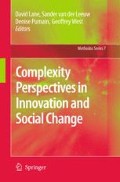Elsewhere, one of us recently argued for the need to develop a wide range of modeling approaches in the social sciences (van der Leeuw, 2005), including archaeology and anthropology. This call reflects a growing interest, on the part of archaeologists and anthropologists, in constructing and using dynamic models, and a growing interest on the part of modelers in the domains these social sciences cover (e.g., Gilbert, 1991; van der Leeuw & McGlade, 1997; Ballot & Weisbuch, 2000; Janssen & Jager, 2000; Kohler & Gumerman, 2000; Janssen, 2002; Anderies, 2006; Kohler & van der Leeuw, 2007; etc.). In this paper, we will attempt to model a specific phenomenon that has occurred, and occurs, in all societies: the creation of novelty (combining invention and innovation).
Access this chapter
Tax calculation will be finalised at checkout
Purchases are for personal use only
Preview
Unable to display preview. Download preview PDF.
References
Anderies, J. (2006). Robustness, institutions, and large-scale change in social-ecological systems: The Hohokam of the Phoenix basin. Journal of Institutional Economics, 2, 133–155.
Ballot, G., & Weisbuch, G. (Eds.). (2000). Applications of simulation to social sciences. Paris, France: Hermes Science Publications.
Böeda, E. (1986). Approche technologique du concept Levallois et évaluation de son champs d,application: étude de trois gisements saaliens et weichseliens de la France septentrionale. Unpublished Ph.D. Thesis, University of Paris X, France.
Böeda, E. (1990). De la surface au volume : analyse des conceptions des débitages Levallois et laminaires. In C. Farizy (Ed.), Paléolithique moyen récent et Paléolithique supérieur ancien en Europe. Ruptures et transitions : examen critique des documents archéologiques -Actes du Colloque international de Nemours, 1988 (pp. 63–68). Nemours: Mémoires du Musée de Préhistoire d,Ile de France.
Bruner, J. S., Goodnow, J. J., & Austin, G. A. (1956). A study of thinking. New York, NY: Wiley.
Falkenhainer, B., Kenneth, F., & Gentner, D. (1989). The structure-mapping engine: Algorithms and Examples. Artificial Intelligence, 41, 1–63.
Fauconnier, G., & Turner, M. (2002). The way we think: Conceptual blending and the mind’s hidden complexities. New York, NY: Basic Books.
Foster, G. W. (1948). Empire’s children. The people of Tzintzuntzan. Washington, DC: Smithsonian Institution, (Institute of Anthropology Publication).
Gäardenfors, P. (2000). Conceptual spaces: The geometry of thought. Cambridge, MA: MIT Press.
Gilbert, N. (1991). Artificial Societies. Guildford, UK: University of Surrey.
Holland, J. (1975). Adaptation in natural and artificial systems. Ann Arbor, MI: University of Michigan Press.
Janssen, M. A., & Jager, W. (2000). The human actor in ecological-economic models. Ecological Economics (Special Issue), 35, 3.
Janssen, M.A. (2002). Complexity and ecosystem management: the theory and practice of multi-agent systems. Cheltenham UK/Northampton, MA: Edward Elgar Publishers.
Kohler, T., & Gumerman, G. (Eds.). (2000). Dynamics in human and primate societies: Agent-based modeling of social and spatial processes. New York: Santa Fe Institute and Oxford University Press.
Kohler, T., & van der Leeuw, S. E. (Eds.). (2007). The model-based archaeology of socionatural systems. Santa Fe, NM: School of American Research.
Lakoff, G. (1987). Women, fire and dangerous things. Chicago, IL: University of Chicago Press.
Lane, D.A., Malerba, F., Maxfield, R., & Orsenigo, L. (1996). Choice and action. Journal of Evolutionary Economics, 6, 43–76.
Macrae, N., & Bodenhausen, G. (2000). Social cognition: Thinking categorically about others. Annual Review of Psychology, 51, 93–120.
Markman, A. B., & Gentner, D. (2001). Thinking. Annual Review of Psychology, 52, 223–247.
Papousek, D. A. (1989). Technological change as social rebellion. In: S. E. van der Leeuw & R. Torrence (Eds.), What’s new: A closer look at the process of innovation (pp. 140–166). London, UK: Unwin and Hyman.
Pigeot, N. (1992). Reflexions sur l‚histoire technique de l‚Homme: de l‚′evolution cognitive ′{a l‚}′evolution culturelle. Paléo, 3, 167–200.
Selby, H. A., & El Guindi, F. (1976). Dialectics in Zapotec thinking. In K. Basso & H. A. Selby (Eds.), Meaning in anthropology (pp. 181–196). Albuquerque, NM: University of New Mexico Press.
Veale, T. (1997). Creativity as pastiche: A computational model of dynamic blending and textual collage, with special reference to the use of blending in cinematic narratives. Proceedings of ICLC’97, the 1997 conference of The International Cognitive Linguistics Association, Amsterdam, The Netherlands.
van der Leeuw, S. E. (1976). Studies in the technology of ancient pottery (Vols. 2). Amsterdam, The Netherlands: University Printing Office.
van der Leeuw, S. E. (1990). Archaeology, material culture and innovation. SubStance 62–63, 92–109.
van der Leeuw, S. E. (1993). Giving the potter a choice: conceptual aspects of pottery techniques. In P. Lemonnier (Ed.), Technological choices: Transformation in material culture from the neolithic to modern high tech (pp. 238–288). London, UK: Routledge Kegan Paul.
van der Leeuw, S. E. (2000). Making tools from stone and clay. In T. Murray, & A. Anderson (Eds.), Australian archaeologist. Collected Papers in Honour of J. Allen (pp. 69–88). Canberra, Australia: ANU Press.
van der Leeuw, S. E. (2005). Why model? Cybernetics and Systems 35(2–3),117–128.
van der Leeuw, S. E., & McGlade, J. (Eds). (1997). Time, process and structural transformations in archaeology. London, UK: Routledge.
van der Leeuw, S. E., & Papousek, D. A. (1992). Tradition and innovation. In F. Audouze, A. Gallay, & V. Roux (Eds.), Ethnoarchéologie: Justification, problémes, limites (pp. 135–158). Antibes, France: A.P.D.C.A.
van der Leeuw, S. E., Papousek, D. A., & Coudart, A. (1992). Technological traditions and unquestioned assumptions. Techniques et Culture 16–17, 145–173.
Author information
Authors and Affiliations
Editor information
Editors and Affiliations
Rights and permissions
Copyright information
© 2009 Springer Science+Business Media B.V.
About this chapter
Cite this chapter
Ferrari, D., Read, D., van der Leeuw, S. (2009). An Agent-Based Model of Information Flows in Social Dynamics. In: Lane, D., Pumain, D., van der Leeuw, S.E., West, G. (eds) Complexity Perspectives in Innovation and Social Change. Methodos Series, vol 7. Springer, Dordrecht. https://doi.org/10.1007/978-1-4020-9663-1_15
Download citation
DOI: https://doi.org/10.1007/978-1-4020-9663-1_15
Publisher Name: Springer, Dordrecht
Print ISBN: 978-1-4020-9662-4
Online ISBN: 978-1-4020-9663-1
eBook Packages: Humanities, Social Sciences and LawSocial Sciences (R0)

